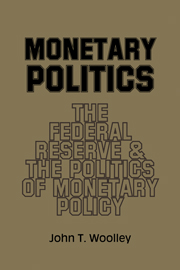Book contents
- Frontmatter
- Contents
- Preface
- 1 The Federal Reserve and the Politics of Monetary Policy: Introduction and Overview
- 2 A Capsule History of the Federal Reserve System
- 3 Recruitment and Selection of Federal Reserve Personnel
- 4 Bankers and the Federal Reserve
- 5 Economists and the Federal Reserve
- 6 The President and the Federal Reserve
- 7 Congress and the Federal Reserve
- 8 Making Monetary Policy in a Political Environment: The Election of 1972
- 9 Monetary Politics: A Summary
- Appendix A A Note on Data Sources
- Appendix B Legislation Included in Table 7.1
- Appendix C Academic Backgrounds and Career Experiences of Notable Monetarists
- Notes
- Bibliographic Note
- Index
Appendix A - A Note on Data Sources
Published online by Cambridge University Press: 01 June 2011
- Frontmatter
- Contents
- Preface
- 1 The Federal Reserve and the Politics of Monetary Policy: Introduction and Overview
- 2 A Capsule History of the Federal Reserve System
- 3 Recruitment and Selection of Federal Reserve Personnel
- 4 Bankers and the Federal Reserve
- 5 Economists and the Federal Reserve
- 6 The President and the Federal Reserve
- 7 Congress and the Federal Reserve
- 8 Making Monetary Policy in a Political Environment: The Election of 1972
- 9 Monetary Politics: A Summary
- Appendix A A Note on Data Sources
- Appendix B Legislation Included in Table 7.1
- Appendix C Academic Backgrounds and Career Experiences of Notable Monetarists
- Notes
- Bibliographic Note
- Index
Summary
This research is based on several sources of information. First, and most important, is the public record. There is a vast amount of public information about monetary policy making. Probably most important are the various kinds of records of the FOMC. Detailed Minutes of the FOMC have been made public with a five-year lag and extend through 1976. With the onset of pressure for greater openness in policy making in 1976–7, the Federal Reserve responded by shortening the time in which it released the record of policy actions from ninety to thirty days and discontinued the practice of keeping “almost verbatim” minutes. Instead, it now publishes a longer policy record in the Federal Reserve Bulletin, a record substantially less revealing than the detailed Minutes, a tradeoff of rapid availability for detail. I am assured that the published record accurately and fairly reflects the issues discussed in meetings. However, for purposes of political analysis of the FOMC, the new procedure is significantly less revealing.
Accuracy of the pre–1977 Minutes
The pre–1977 Minutes, which as of this writing are available through 1975, are in an edited, semiverbatim form, based on transcriptions of tape recordings of meetings. Copies are available to the public at Federal Reserve Board offices and at all Federal Reserve banks, and microfilm copies may be purchased from the National Archives. Debate is reported in the third person.
- Type
- Chapter
- Information
- Monetary PoliticsThe Federal Reserve and the Politics of Monetary Policy, pp. 195 - 202Publisher: Cambridge University PressPrint publication year: 1984

